Page 9 of 95
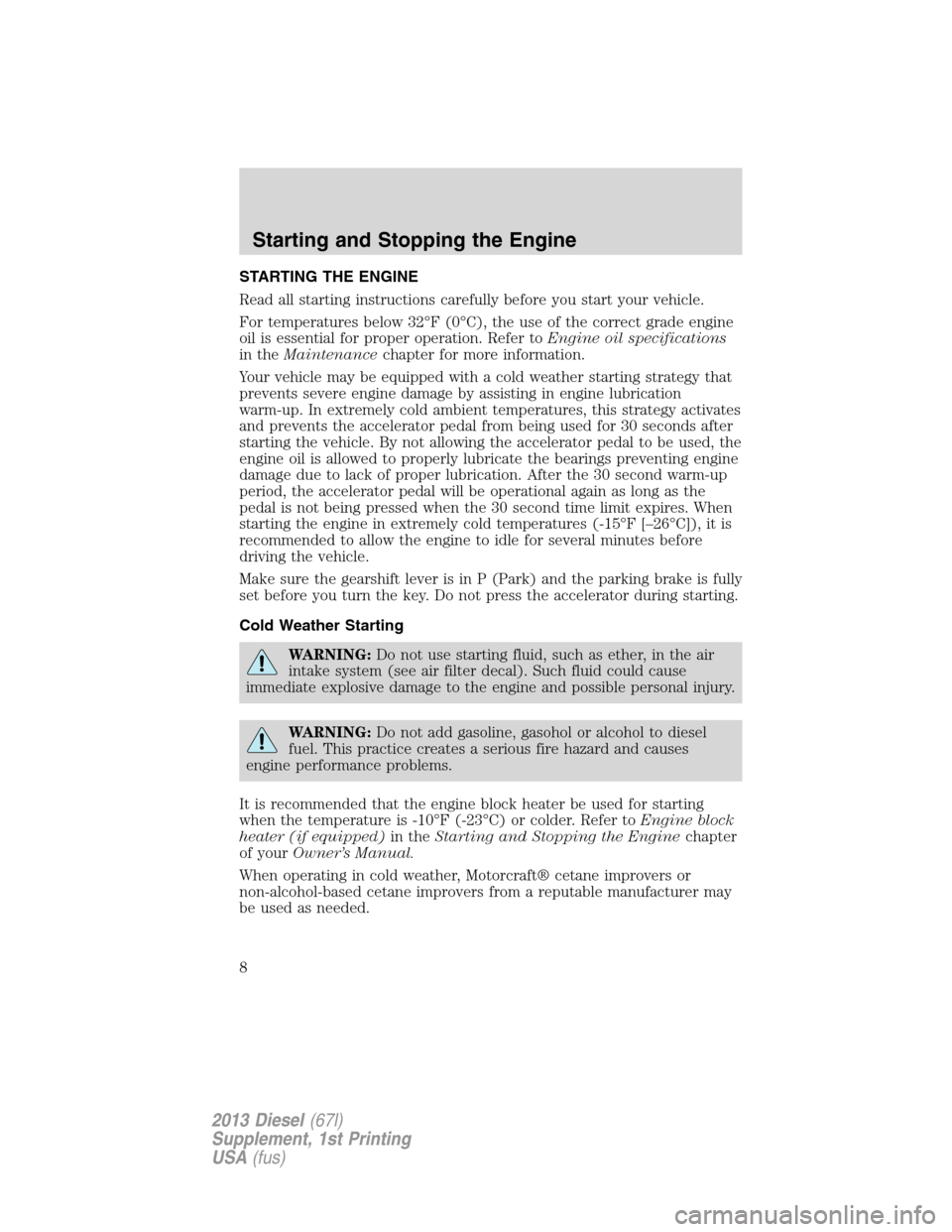
STARTING THE ENGINE
Read all starting instructions carefully before you start your vehicle.
For temperatures below 32°F (0°C), the use of the correct grade engine
oil is essential for proper operation. Refer toEngine oil specifications
in theMaintenancechapter for more information.
Your vehicle may be equipped with a cold weather starting strategy that
prevents severe engine damage by assisting in engine lubrication
warm-up. In extremely cold ambient temperatures, this strategy activates
and prevents the accelerator pedal from being used for 30 seconds after
starting the vehicle. By not allowing the accelerator pedal to be used, the
engine oil is allowed to properly lubricate the bearings preventing engine
damage due to lack of proper lubrication. After the 30 second warm-up
period, the accelerator pedal will be operational again as long as the
pedal is not being pressed when the 30 second time limit expires. When
starting the engine in extremely cold temperatures (-15°F [–26°C]), it is
recommended to allow the engine to idle for several minutes before
driving the vehicle.
Make sure the gearshift lever is in P (Park) and the parking brake is fully
set before you turn the key. Do not press the accelerator during starting.
Cold Weather Starting
WARNING:Do not use starting fluid, such as ether, in the air
intake system (see air filter decal). Such fluid could cause
immediate explosive damage to the engine and possible personal injury.
WARNING:Do not add gasoline, gasohol or alcohol to diesel
fuel. This practice creates a serious fire hazard and causes
engine performance problems.
It is recommended that the engine block heater be used for starting
when the temperature is -10°F (-23°C) or colder. Refer toEngine block
heater (if equipped)in theStarting and Stopping the Enginechapter
of yourOwner’s Manual.
When operating in cold weather, Motorcraft® cetane improvers or
non-alcohol-based cetane improvers from a reputable manufacturer may
be used as needed.
Starting and Stopping the Engine
8
2013 Diesel(67l)
Supplement, 1st Printing
USA(fus)
Page 10 of 95
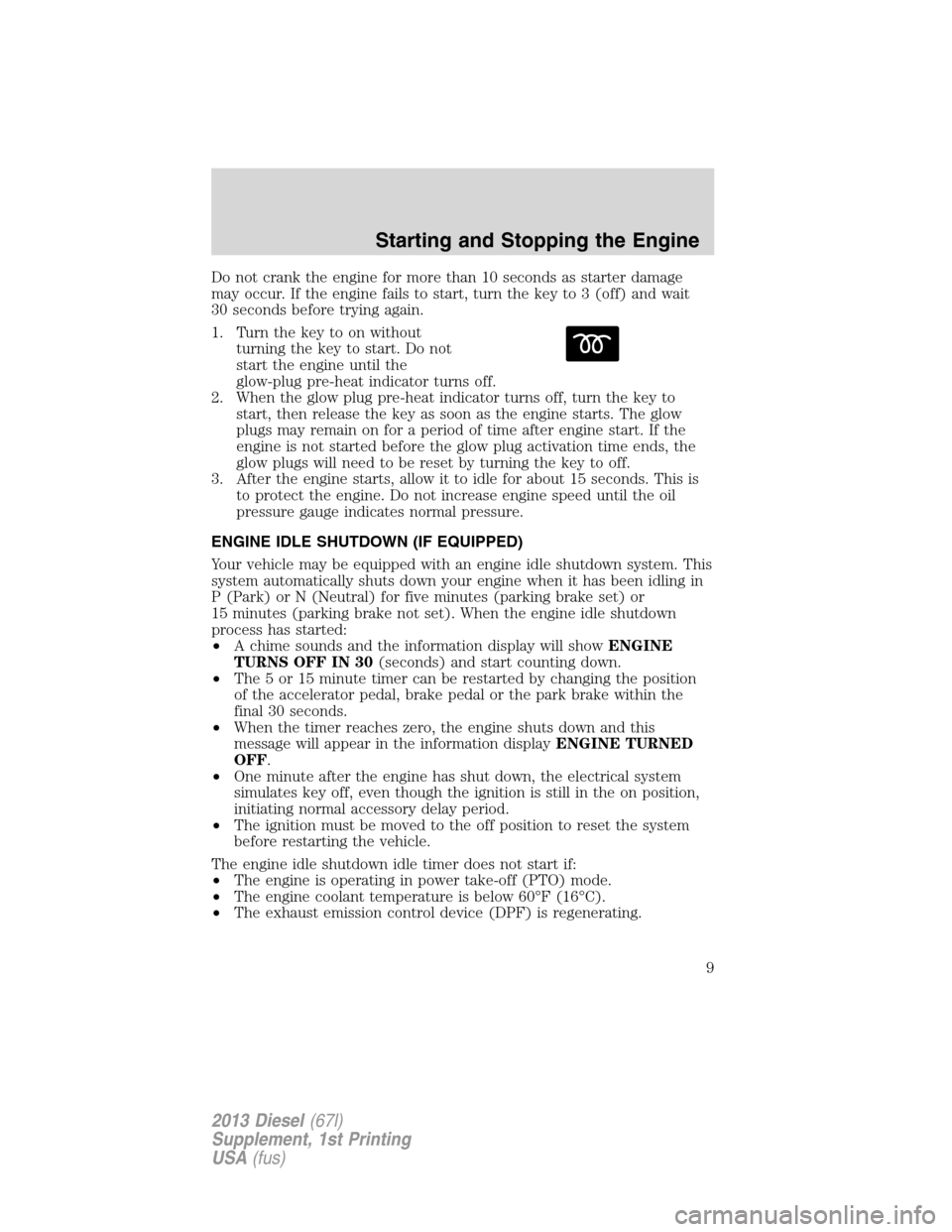
Do not crank the engine for more than 10 seconds as starter damage
may occur. If the engine fails to start, turn the key to 3 (off) and wait
30 seconds before trying again.
1. Turn the key to on without
turning the key to start. Do not
start the engine until the
glow-plug pre-heat indicator turns off.
2. When the glow plug pre-heat indicator turns off, turn the key to
start, then release the key as soon as the engine starts. The glow
plugs may remain on for a period of time after engine start. If the
engine is not started before the glow plug activation time ends, the
glow plugs will need to be reset by turning the key to off.
3. After the engine starts, allow it to idle for about 15 seconds. This is
to protect the engine. Do not increase engine speed until the oil
pressure gauge indicates normal pressure.
ENGINE IDLE SHUTDOWN (IF EQUIPPED)
Your vehicle may be equipped with an engine idle shutdown system. This
system automatically shuts down your engine when it has been idling in
P (Park) or N (Neutral) for five minutes (parking brake set) or
15 minutes (parking brake not set). When the engine idle shutdown
process has started:
•A chime sounds and the information display will showENGINE
TURNS OFF IN 30(seconds) and start counting down.
•The 5 or 15 minute timer can be restarted by changing the position
of the accelerator pedal, brake pedal or the park brake within the
final 30 seconds.
•When the timer reaches zero, the engine shuts down and this
message will appear in the information displayENGINE TURNED
OFF.
•One minute after the engine has shut down, the electrical system
simulates key off, even though the ignition is still in the on position,
initiating normal accessory delay period.
•The ignition must be moved to the off position to reset the system
before restarting the vehicle.
The engine idle shutdown idle timer does not start if:
•The engine is operating in power take-off (PTO) mode.
•The engine coolant temperature is below 60°F (16°C).
•The exhaust emission control device (DPF) is regenerating.
Starting and Stopping the Engine
9
2013 Diesel(67l)
Supplement, 1st Printing
USA(fus)
Page 11 of 95
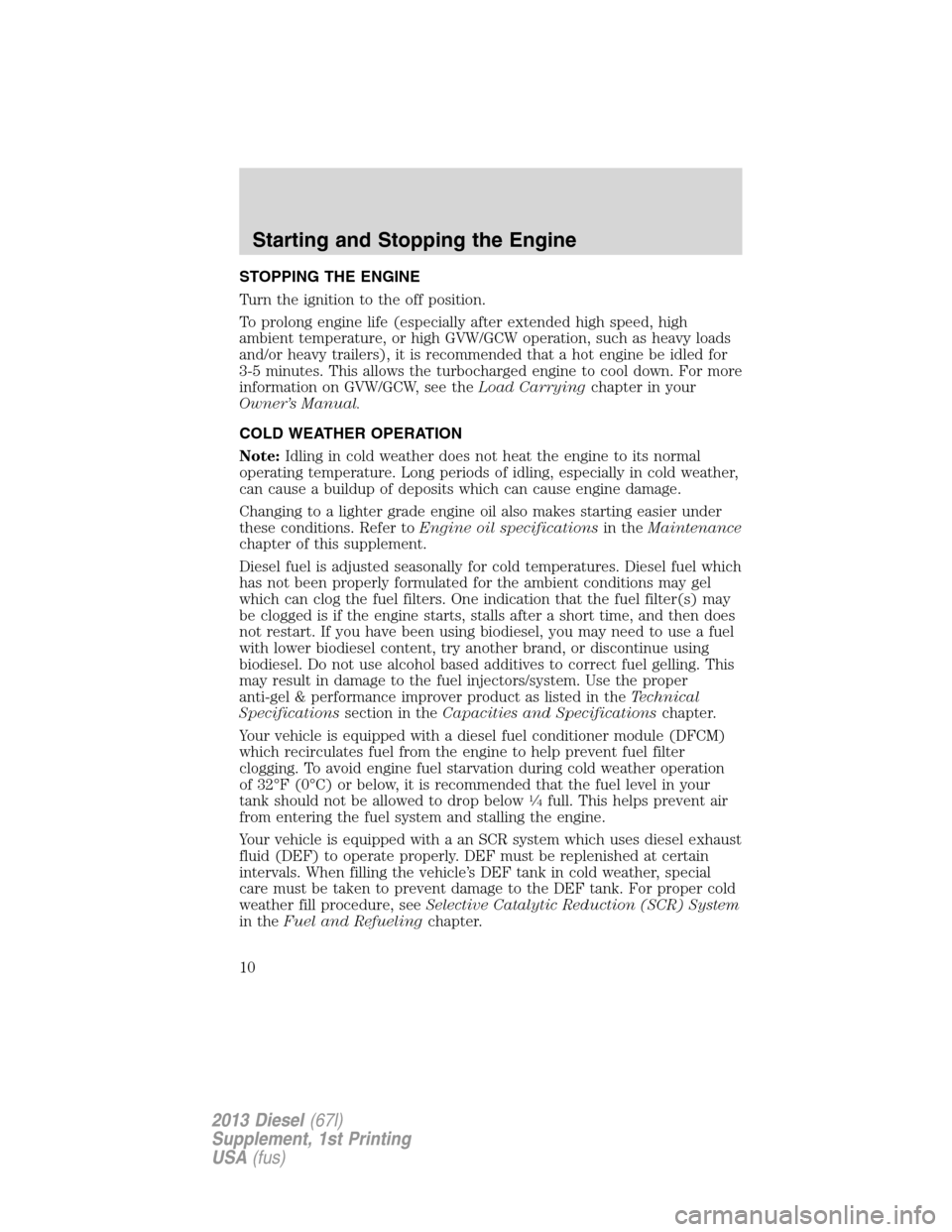
STOPPING THE ENGINE
Turn the ignition to the off position.
To prolong engine life (especially after extended high speed, high
ambient temperature, or high GVW/GCW operation, such as heavy loads
and/or heavy trailers), it is recommended that a hot engine be idled for
3-5 minutes. This allows the turbocharged engine to cool down. For more
information on GVW/GCW, see theLoad Carryingchapter in your
Owner’s Manual.
COLD WEATHER OPERATION
Note:Idling in cold weather does not heat the engine to its normal
operating temperature. Long periods of idling, especially in cold weather,
can cause a buildup of deposits which can cause engine damage.
Changing to a lighter grade engine oil also makes starting easier under
these conditions. Refer toEngine oil specificationsin theMaintenance
chapter of this supplement.
Diesel fuel is adjusted seasonally for cold temperatures. Diesel fuel which
has not been properly formulated for the ambient conditions may gel
which can clog the fuel filters. One indication that the fuel filter(s) may
be clogged is if the engine starts, stalls after a short time, and then does
not restart. If you have been using biodiesel, you may need to use a fuel
with lower biodiesel content, try another brand, or discontinue using
biodiesel. Do not use alcohol based additives to correct fuel gelling. This
may result in damage to the fuel injectors/system. Use the proper
anti-gel & performance improver product as listed in theTechnical
Specificationssection in theCapacities and Specificationschapter.
Your vehicle is equipped with a diesel fuel conditioner module (DFCM)
which recirculates fuel from the engine to help prevent fuel filter
clogging. To avoid engine fuel starvation during cold weather operation
of 32°F (0°C) or below, it is recommended that the fuel level in your
tank should not be allowed to drop below
1�4full. This helps prevent air
from entering the fuel system and stalling the engine.
Your vehicle is equipped with a an SCR system which uses diesel exhaust
fluid (DEF) to operate properly. DEF must be replenished at certain
intervals. When filling the vehicle’s DEF tank in cold weather, special
care must be taken to prevent damage to the DEF tank. For proper cold
weather fill procedure, seeSelective Catalytic Reduction (SCR) System
in theFuel and Refuelingchapter.
Starting and Stopping the Engine
10
2013 Diesel(67l)
Supplement, 1st Printing
USA(fus)
Page 12 of 95

In cold weather below 32°F (0°C), the engine may slowly increase to a
higher idle speed if left idling in P (Park). As the engine warms-up, the
engine sound level decreases due to the activation of PCM-controlled
sound reduction features.
If your vehicle is operated in a heavy snow storm or blowing snow
conditions, the engine air induction may become partially clogged with
snow and/or ice. If this occurs, the engine may experience a significant
reduction in power output. At the earliest opportunity, clear all the snow
and/or ice away from inside the air filter assembly. Remove the air
cleaner cover and the pleated paper filter, leaving the foam filter in and
remove any snow or ice. Make sure the foam filter is installed correctly
in place. Remove any debris, snow and/or ice on the foam filter by
brushing the surface with soft brush. Do not use water, solvents, or a
hard brush for cleaning the foam filter.
In order to operate the engine in temperatures of 32°F (0°C) or lower,
read the following instructions:
•Make sure that the batteries are of sufficient size and are fully
charged. Check other electrical components to make sure they are in
optimum condition.
•Use the proper coolant solution at the concentration recommended to
protect the engine against damage from freezing.
•Try to keep the fuel tank full as much as possible at the end of
operation to prevent condensation in the fuel system.
•Make sure you use proper cold weather engine oil and that it is at its
proper level. Also, if necessary, make sure to follow the engine oil and
filter change schedule found under theSpecial operating conditions
section listed in thescheduled maintenance information.
•At temperatures of -10°F (-23°C) or below, it is recommended that
you use an engine block heater to improve cold engine starting.
•If operating in arctic temperatures of -20°F (-29°C) or lower, consult
your truck dealer for information about special cold weather
equipment and precautions.
The following cold weather idling guidelines are recommended:
•Motorcraft® cetane improvers or non-alcohol-based cetane improvers
from a reputable manufacturer may be used as needed.
•Maintain the engine cooling system properly.
•Avoid shutting the engine down after an extensive idling period. Drive
the vehicle for several miles with the engine at normal operating
temperatures under a moderate load.
•Consider using an engine block heater.
•For extended idle times use an approved idle speed increase device.
Starting and Stopping the Engine
11
2013 Diesel(67l)
Supplement, 1st Printing
USA(fus)
Page 13 of 95
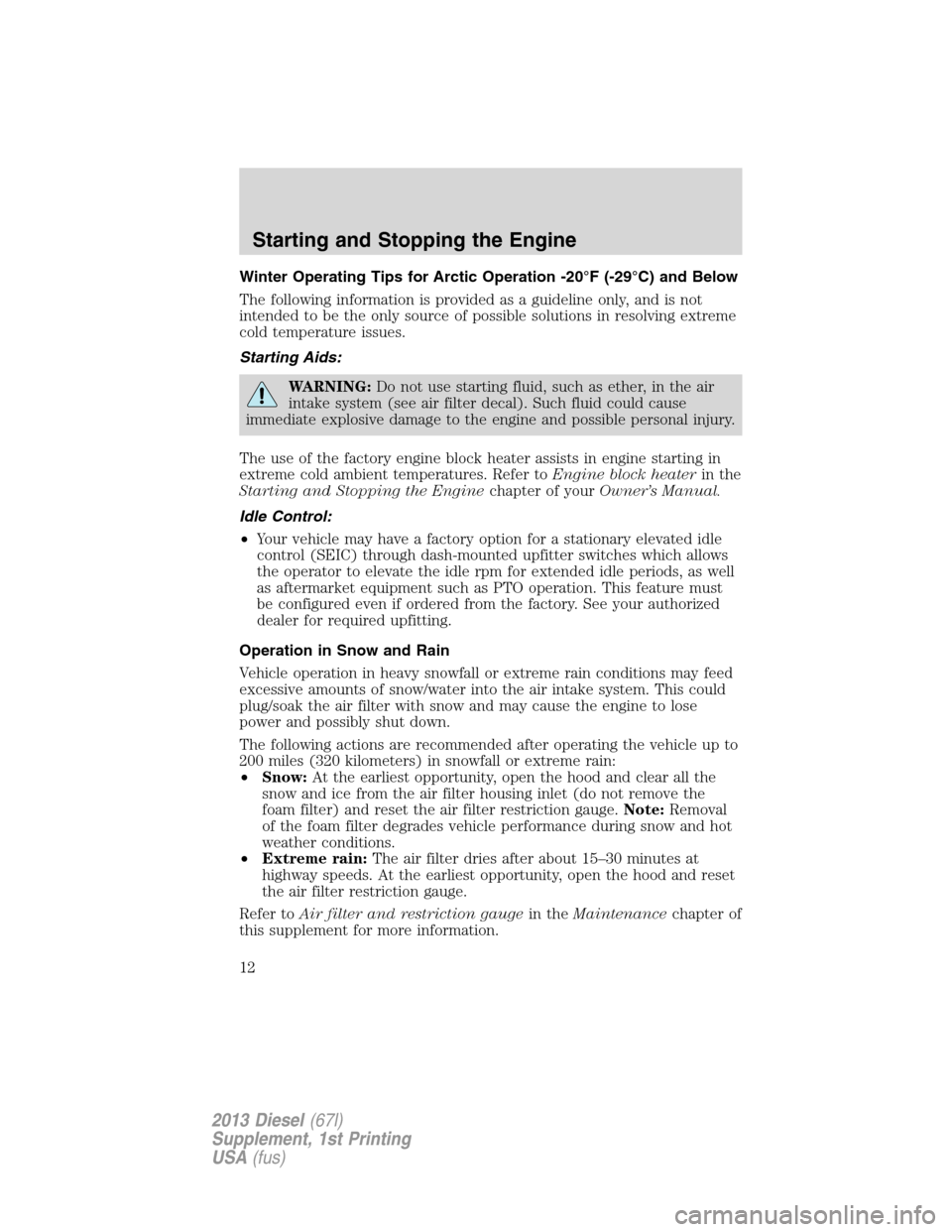
Winter Operating Tips for Arctic Operation -20°F (-29°C) and Below
The following information is provided as a guideline only, and is not
intended to be the only source of possible solutions in resolving extreme
cold temperature issues.
Starting Aids:
WARNING:Do not use starting fluid, such as ether, in the air
intake system (see air filter decal). Such fluid could cause
immediate explosive damage to the engine and possible personal injury.
The use of the factory engine block heater assists in engine starting in
extreme cold ambient temperatures. Refer toEngine block heaterin the
Starting and Stopping the Enginechapter of yourOwner’s Manual.
Idle Control:
•Your vehicle may have a factory option for a stationary elevated idle
control (SEIC) through dash-mounted upfitter switches which allows
the operator to elevate the idle rpm for extended idle periods, as well
as aftermarket equipment such as PTO operation. This feature must
be configured even if ordered from the factory. See your authorized
dealer for required upfitting.
Operation in Snow and Rain
Vehicle operation in heavy snowfall or extreme rain conditions may feed
excessive amounts of snow/water into the air intake system. This could
plug/soak the air filter with snow and may cause the engine to lose
power and possibly shut down.
The following actions are recommended after operating the vehicle up to
200 miles (320 kilometers) in snowfall or extreme rain:
•Snow:At the earliest opportunity, open the hood and clear all the
snow and ice from the air filter housing inlet (do not remove the
foam filter) and reset the air filter restriction gauge.Note:Removal
of the foam filter degrades vehicle performance during snow and hot
weather conditions.
•Extreme rain:The air filter dries after about 15–30 minutes at
highway speeds. At the earliest opportunity, open the hood and reset
the air filter restriction gauge.
Refer toAir filter and restriction gaugein theMaintenancechapter of
this supplement for more information.
Starting and Stopping the Engine
12
2013 Diesel(67l)
Supplement, 1st Printing
USA(fus)
Page 14 of 95
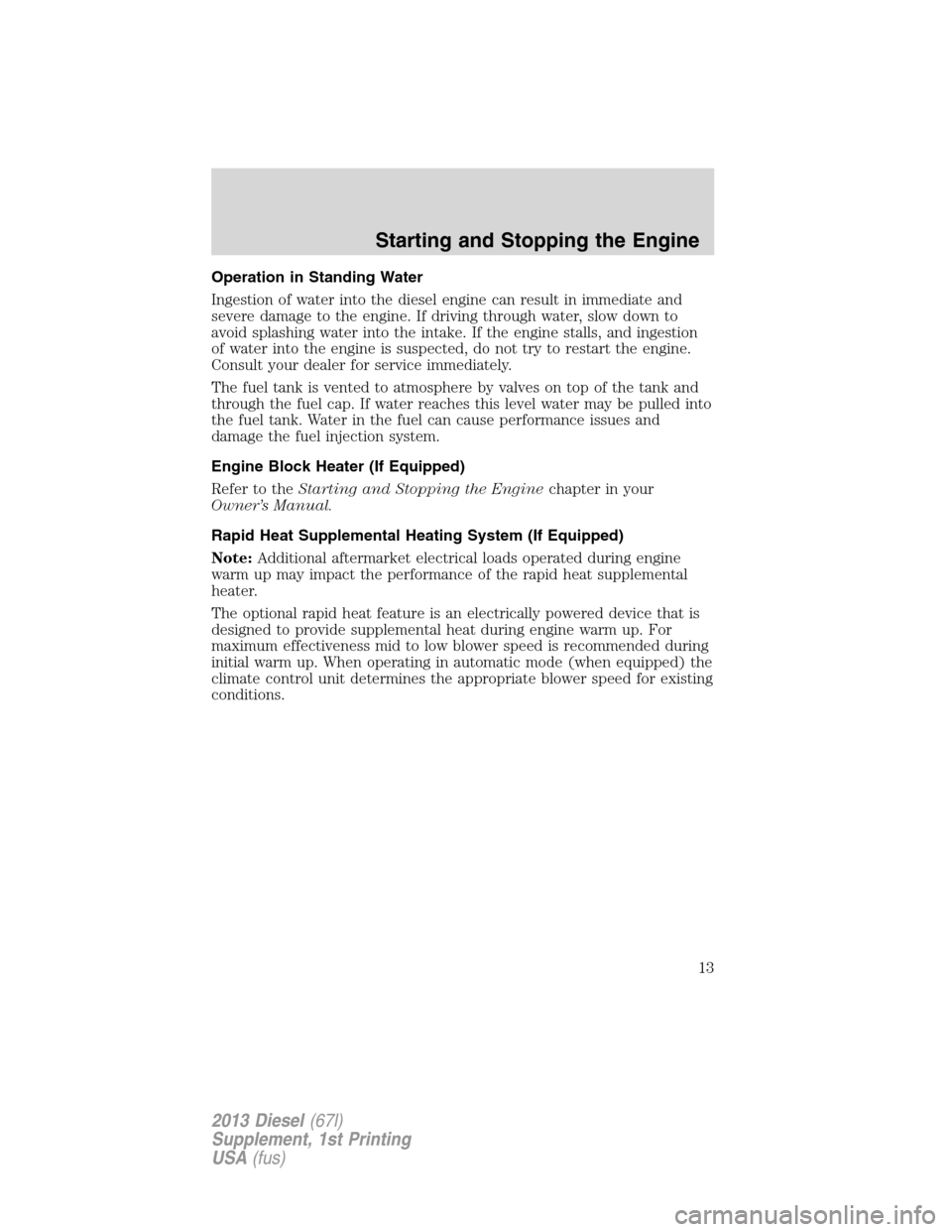
Operation in Standing Water
Ingestion of water into the diesel engine can result in immediate and
severe damage to the engine. If driving through water, slow down to
avoid splashing water into the intake. If the engine stalls, and ingestion
of water into the engine is suspected, do not try to restart the engine.
Consult your dealer for service immediately.
The fuel tank is vented to atmosphere by valves on top of the tank and
through the fuel cap. If water reaches this level water may be pulled into
the fuel tank. Water in the fuel can cause performance issues and
damage the fuel injection system.
Engine Block Heater (If Equipped)
Refer to theStarting and Stopping the Enginechapter in your
Owner’s Manual.
Rapid Heat Supplemental Heating System (If Equipped)
Note:Additional aftermarket electrical loads operated during engine
warm up may impact the performance of the rapid heat supplemental
heater.
The optional rapid heat feature is an electrically powered device that is
designed to provide supplemental heat during engine warm up. For
maximum effectiveness mid to low blower speed is recommended during
initial warm up. When operating in automatic mode (when equipped) the
climate control unit determines the appropriate blower speed for existing
conditions.
Starting and Stopping the Engine
13
2013 Diesel(67l)
Supplement, 1st Printing
USA(fus)
Page 15 of 95
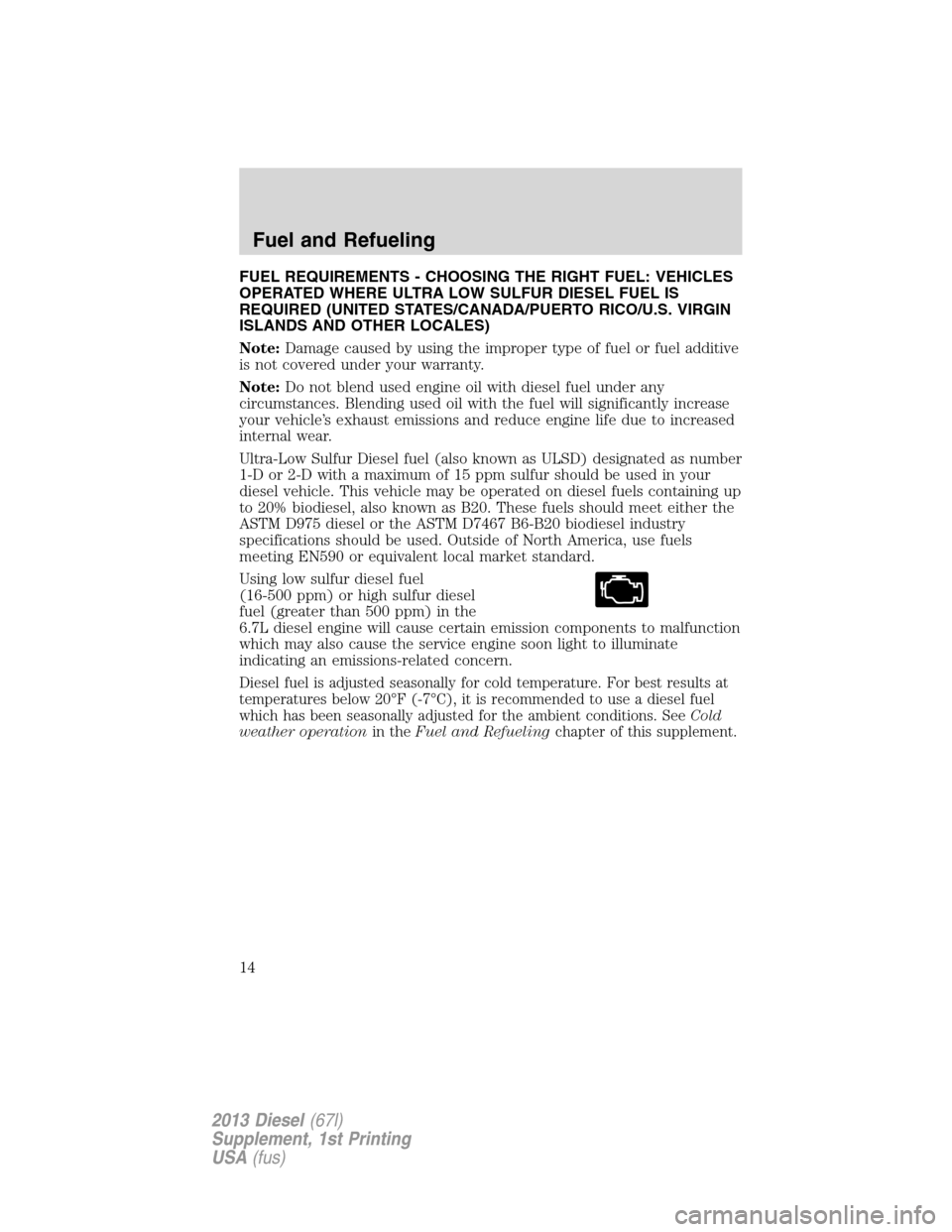
FUEL REQUIREMENTS - CHOOSING THE RIGHT FUEL: VEHICLES
OPERATED WHERE ULTRA LOW SULFUR DIESEL FUEL IS
REQUIRED (UNITED STATES/CANADA/PUERTO RICO/U.S. VIRGIN
ISLANDS AND OTHER LOCALES)
Note:Damage caused by using the improper type of fuel or fuel additive
is not covered under your warranty.
Note:Do not blend used engine oil with diesel fuel under any
circumstances. Blending used oil with the fuel will significantly increase
your vehicle’s exhaust emissions and reduce engine life due to increased
internal wear.
Ultra-Low Sulfur Diesel fuel (also known as ULSD) designated as number
1-D or 2-D with a maximum of 15 ppm sulfur should be used in your
diesel vehicle. This vehicle may be operated on diesel fuels containing up
to 20% biodiesel, also known as B20. These fuels should meet either the
ASTM D975 diesel or the ASTM D7467 B6-B20 biodiesel industry
specifications should be used. Outside of North America, use fuels
meeting EN590 or equivalent local market standard.
Using low sulfur diesel fuel
(16-500 ppm) or high sulfur diesel
fuel (greater than 500 ppm) in the
6.7L diesel engine will cause certain emission components to malfunction
which may also cause the service engine soon light to illuminate
indicating an emissions-related concern.
Diesel fuel is adjusted seasonally for cold temperature. For best results at
temperatures below 20°F (-7°C), it is recommended to use a diesel fuel
which has been seasonally adjusted for the ambient conditions. SeeCold
weather operationin theFuel and Refuelingchapter of this supplement.
Fuel and Refueling
14
2013 Diesel(67l)
Supplement, 1st Printing
USA(fus)
Page 16 of 95
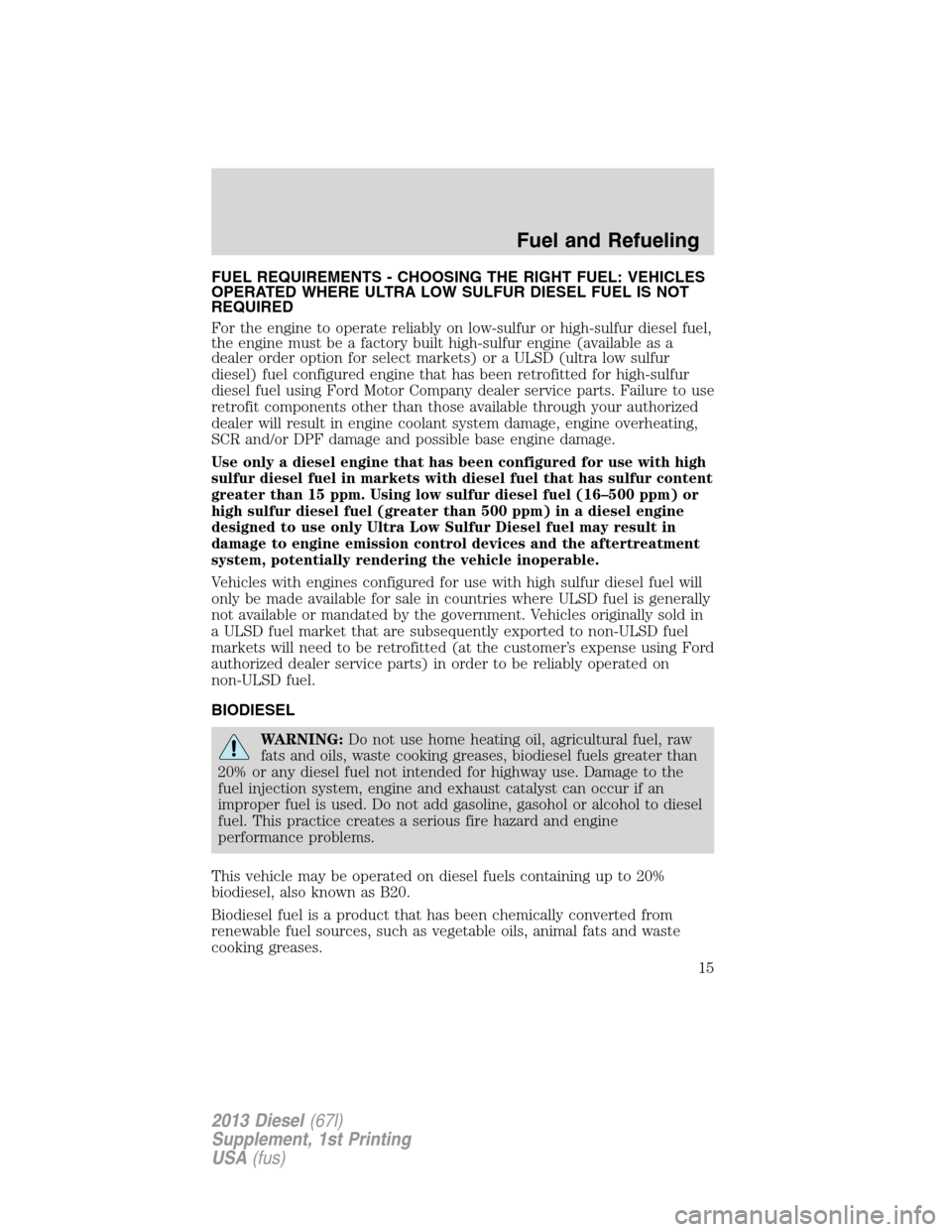
FUEL REQUIREMENTS - CHOOSING THE RIGHT FUEL: VEHICLES
OPERATED WHERE ULTRA LOW SULFUR DIESEL FUEL IS NOT
REQUIRED
For the engine to operate reliably on low-sulfur or high-sulfur diesel fuel,
the engine must be a factory built high-sulfur engine (available as a
dealer order option for select markets) or a ULSD (ultra low sulfur
diesel) fuel configured engine that has been retrofitted for high-sulfur
diesel fuel using Ford Motor Company dealer service parts. Failure to use
retrofit components other than those available through your authorized
dealer will result in engine coolant system damage, engine overheating,
SCR and/or DPF damage and possible base engine damage.
Use only a diesel engine that has been configured for use with high
sulfur diesel fuel in markets with diesel fuel that has sulfur content
greater than 15 ppm. Using low sulfur diesel fuel (16–500 ppm) or
high sulfur diesel fuel (greater than 500 ppm) in a diesel engine
designed to use only Ultra Low Sulfur Diesel fuel may result in
damage to engine emission control devices and the aftertreatment
system, potentially rendering the vehicle inoperable.
Vehicles with engines configured for use with high sulfur diesel fuel will
only be made available for sale in countries where ULSD fuel is generally
not available or mandated by the government. Vehicles originally sold in
a ULSD fuel market that are subsequently exported to non-ULSD fuel
markets will need to be retrofitted (at the customer’s expense using Ford
authorized dealer service parts) in order to be reliably operated on
non-ULSD fuel.
BIODIESEL
WARNING:Do not use home heating oil, agricultural fuel, raw
fats and oils, waste cooking greases, biodiesel fuels greater than
20% or any diesel fuel not intended for highway use. Damage to the
fuel injection system, engine and exhaust catalyst can occur if an
improper fuel is used. Do not add gasoline, gasohol or alcohol to diesel
fuel. This practice creates a serious fire hazard and engine
performance problems.
This vehicle may be operated on diesel fuels containing up to 20%
biodiesel, also known as B20.
Biodiesel fuel is a product that has been chemically converted from
renewable fuel sources, such as vegetable oils, animal fats and waste
cooking greases.
Fuel and Refueling
15
2013 Diesel(67l)
Supplement, 1st Printing
USA(fus)